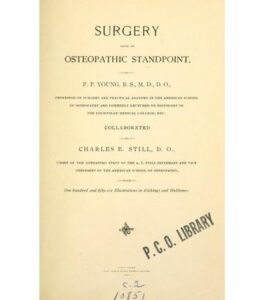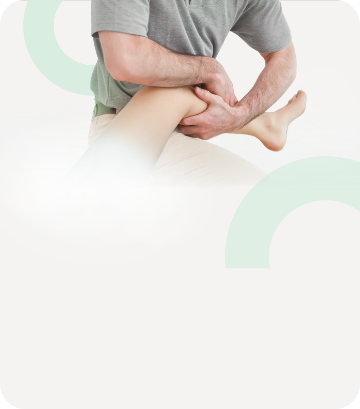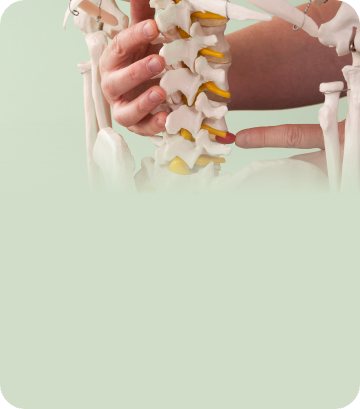Surgery from an Osteopathic Standpoint by Frank Philip Young
As the title says, this is a volume specifically focused on surgery as understood by osteopathic science.

Publisher: Quincy, Illinois (USA): Volk, Jones & McMein Company
Year of publication: 1904
Number of pages: 478
Young, a lecturer at the ASO and a surgeon in the clinical facilities linked to the Kirksville school, declares in the preface that his intention was to present the essential facts of practical surgery modified in the light of the osteopathic theories of Dr A.T. Still.
Written with a vision of brevity and clarity in cooperation with Charles E. Still, son of the founder of ASO and involved in its administrative management, and with the advice of Dr George M. Laughlin.
The work contains 156 illustrations that, apart from the X-Rays, were crafted by two students of the ASO.
The volume is divided into three parts, the first one on general pathology and surgical diseases, the second on pathologies and lesions of particular tissues and the third on pathologies and lesions affecting specific regions. Each part is divided into chapters. For each pathology there are different paragraphs providing the pathology description, symptoms and treatment, both osteopathic and surgical.
Overall the book presents, explains and defines many subjects in an orderly manner, like, for example, inflammation, antiseptics, gangrene, septicemia and many more. The book also describes the bacteria at risk of proliferation during surgery, explaining their distribution in nature, how they reproduce and their effects on the human body. Where applicable, it describes the osteopathic treatments best suited to the specific situation.
The analytical index at the end of the volume facilitates its consultation.
Strengths:
- The language is clear, the concepts are presented in a logical and concise manner;
- A detailed index at the beginning of the book for easy reference;
- There are many explanatory drawings.
- Part I – General Surgical Pathology and Surgical Diseases
- Inflammation
- Surgical bacteria
- Antiseptics
- Asepsis
- Suppuration, abscess, ulcer, fistula and sinus
- Gangrene
- Septic and infective diseases
- Wound fever
- Sapremia
- Septicemia
- Pyemia
- Diphtheria
- Erysipelas
- Tetanus
- Hydrophobia
- Actinomycosis
- Malignant pustule
- Tuberculosis
- Glanders
- Syphilis
- Gonorrhea
- Rachitis
- Scurvy
- Tumors
- Cysts
- Bandaging
- Anesthesia
- Process of repair
- Wounds
- Shock
- Burns and scalds
- Part II – Pathologies and lesions of special tissues
- Heart and pericardium
- Arteries
- Aneurysm
- Ligation of arteries
- Veins
- Embolism
- Thrombosis
- Lymphatics
- Skin
- Nerves
- Bones and joints
- Fractures
- Diseases of joints
- Dislocations
- Pathologies and injuries of the spine
- Pathologies and injuries of the head
- Pathologies and injuries of muscles, tendons, fascia and bursae
- Club-foot
- Part III – diseases and injuries of regions
- Face, lips, tongue, mouth and throat
- Chest
- Digestive tract, abdomen and pelvis
- Rectus and anus
- Urinary organs
- Male genitalia
- Female genitalia
- Mammary gland

Are you an osteopath?
Register and enjoy the membership benefits. Create your public profile and publish your studies. It's free!
Register now
School or training institution?
Register and enjoy the membership benefits. Create your public profile and publish your studies. It's free!
Register now
Do you want to become an osteopath? Are you a student?
Register and enjoy the membership benefits. Create your public profile and publish your studies. It's free!
Register nowHistorical osteopathy books
Osteopathy Research and Practice by Andrew Taylor Still
The fourth book of A.T. Still, written at the age of 82 years, enunciates the principles and the practical maneuvers of osteopathy in reference to the single pathologies, classified by body regions.
ReadHistory of Osteopathy and Twentieth-Century Medical Practice by Emmons Rutledge Booth
A milestone in the history of osteopathy. Emmons Rutledge Booth, who enrolled at the ASO in Kirksville in 1898 and graduated in 1900, met A.T. Still personally.
ReadPhilosophy of Osteopathy by Andrew Taylor Still
The second book published by A.T. Still, it collects the basic principles of osteopathy, written over several years and then gathered in one volume. Despite the insistence of his friends, Still was not sure that the time was ripe to divulge his early science.
ReadAutobiography of Andrew Taylor Still with a History of the Discovery and Development of the Science of Osteopathy by A. T. Still
A fundamental text to begin to know the founder of osteopathy and to understand the cultural context and the historical events during which his life unfolded.
ReadPrimitive Physick: or, an Easy and Natural Method of Curing most Diseases by John Wesley
A fundamental text for the Methodists, which Still’s father surely knew and probably owned - in addition to remedies, the book contains a preface that dispenses advice for a healthy life.
ReadThe Old Doctor by Leon Elwin Page
A small volume dedicated to the story of Andrew Taylor Still, and to the birth and development of the idea of osteopathy.
ReadThe Cure of Disease by Osteopathy, Hydropathy and Hygiene A Book for the People by Ferdinand L. Matthay
A small volume addressed to the general public, dispensing health advice and illustrating some osteopathic techniques.
ReadOsteopathy; the New Science by William Livingston Harlan
The volume collects and comments a series of relevant articles on the new science of osteopathy, highlighting legal, historical and theoretical aspects.
ReadA Manual of Osteopathy – with the Application of Physical Culture, Baths and Diet by Eduard W Goetz
Very schematic volume, with the aim of spreading the osteopathic application techniques to everybody, even to those lacking any sort of health training.
Read







